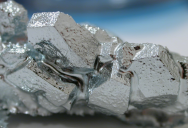Gallium Is A “Melting Metal” That’s Shaking Up Established Scientific Theories Due To Unexpected Test Results Involving Neutrinos
by Michael Levanduski

Gallium is an interesting element. When you look at it, it is a silvery metal that doesn’t seem to be anything special. When you pick it up, however, it will melt in your hand.
This is because it has a low melting point of around 85F.
There are two stable isotopes of gallium, one of which can be used to study solar neutrinos, which is why it is such an important element.
When an atom of gallium-71 comes into contact with electron neutrinos, it will decay into germanium-71 plus one electron. The germanium-71 has a half-life of just 11.4 days, and it decays back into gallium. This allows scientists to study neutrinos.
Neutrinos are known to come in three different types, called electron neutrinos, tau neutrinos, and muon neutrinos. They are extremely small.
So small, in fact, that an estimated 100 trillion neutrinos pass through a person’s body every second.
Neutrinos can come from a variety of sources, but here on Earth, most of them come from the sun.
Interestingly, as a neutrino travels, it can change between these three types in a predictable way.
Scientists have been studying neutrinos using gallium-71 for decades. The problem, however, is that the results aren’t what they expect.

Researchers in this area rely on the Standard Model of Particle Physics as it is a theory that has been tested countless times and is exceptionally useful for scientists.
According to the theory, however, experiments with gallium-71 should produce more germanium-71 than is being seen.
This is not just a problem that can be ignored as an anomaly in one test either. A Soviet-American Gallium Experiment started in 1989 and ran for decades, revealing the problem.
Two years after that, another experiment was started in Italy called GALLEX. It produced the same unexpected results.
And to be clear, the results aren’t even close to what is expected. Scientists would expect about 20-24% more germanium-71 to be produced than they are actually observing.
They have already ruled out several causes including an inaccurate half-life of germanium and explanations for how the interaction between neutrinos and gallium occurred.
Some researchers are now proposing that there may be a fourth type of neutrino, which they are calling a sterile neutrino.

The problem with this theory is that it had been rejected in other experiments and of course, this type of neutrino has never been observed. Researchers who support the theory, however, are quick to point out that it would explain the ‘missing’ germanium-71.
Further research is needed, but it is interesting to see how gallium, which many people just know as that funny liquid metal, is really shaking up many areas of the scientific community.
As for me, I just like the way the metal melts when you pick it up.
If you thought that was interesting, you might like to read a story that reveals Earth’s priciest precious metal isn’t gold or platinum and costs over $10,000 an ounce!
Categories: SCI/TECH
Tags: · elements, gallium, germanium, liquid metal, metal, missing elements, neutrinos, science, single topic, sun, theory, top

Sign up to get our BEST stories of the week straight to your inbox.




